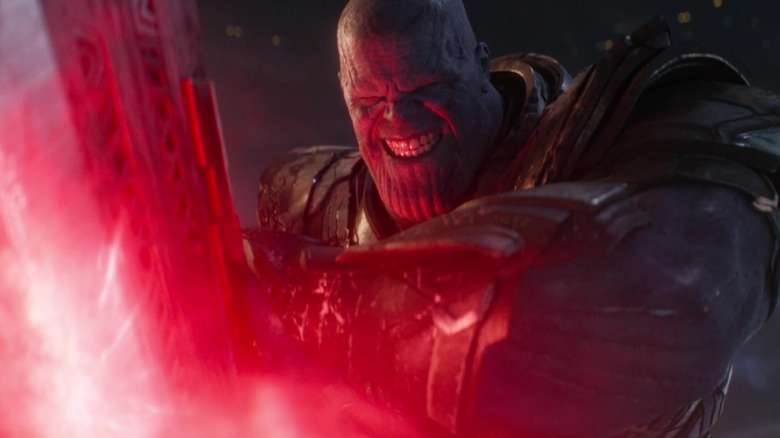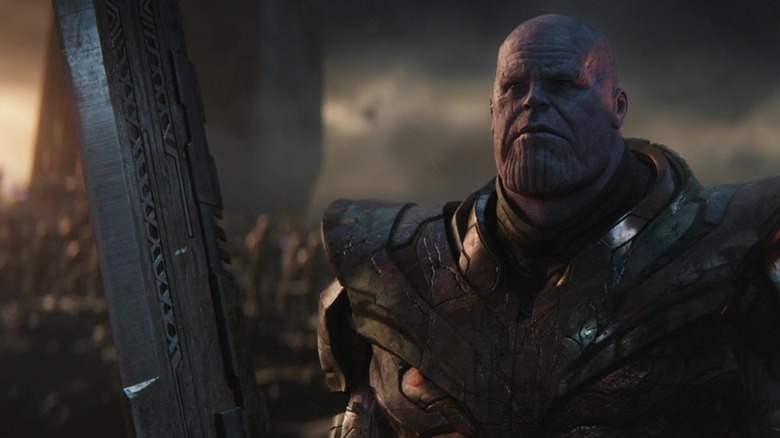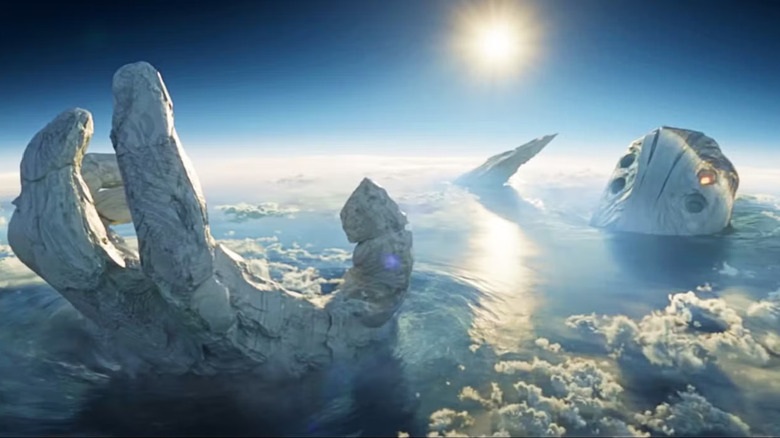What Is Thanos' Double-Edged Sword Made Of In Marvel's Avengers: Endgame?
The climax of Anthony and Joe Russo's ultra-blockbuster "Avengers: Endgame" was a battle between the powerful warmongering space alien Thanos (Josh Brolin) and about 40 superhero characters, all introduced over the course of the 21 previous movies in the Marvel Cinematic Universe. The battle is the moment when the MCU dispenses with story, cleverness, character, or nuance, and goes for the throat, allowing those superheroes to give a beatdown to Thanos and his minions for 37 full minutes. The sequence ends with Iron Man (Robert Downey, Jr.) murdering Thanos and his many, many minions with a set of magical wish stones. The moral implications of Iron Man's mass murder in "Endgame" aren't dealt with, but no one much cared. Fans came for the biff-boom-pow of it all.
Indeed, it was more fun for MCU fans to just see the franchise's heroes use their weapons, widgets, and powers at the same time. Some people cheered when Captain America (Chris Evans) was able to use Thor's (Chris Hemsworth) magical hammer Mjølnir, something he hadn't done in previous MCU films. Characters also used guns, gauntlets, magic, comet-like abilities, and pegasuses to wound the invading aliens. This was not the time to wrestle with ethical conundrums, daddy issues, or governmental oversight. This was the time to unleash an orgy of fantasy violence.
Among the weapons featured in this sequence was the two-bladed sword that Thanos carried. It was longer than Thanos was tall and had a handle in the middle. The whole thing looked pretty badass and seemed to glow from within, perhaps powered by some unknown battery. Thanos, being about nine feet tall and made of pure, mystical, alien muscles, was able to wield the sword with ease.
It's not explicitly stated in the movie, but Marvel Comics fans have theorized that Thanos' sword is made of a mystical metal called Uru — the same substance as Mjølnir.
What is Uru and how is it connected to Thor?
Per the mythology laid out in 2020s Marvel comics, Uru is a metal-like stone that originated on an impossibly ancient moon and is one of the earliest known ores. It is said to possess mystical properties because of its temporal proximity to the Big Bang, allowing it to absorb and store magical energy like a battery. Uru can only be found on the planet of Nidavellir, which exists in the same dimension as Thor's homeworld Asgard. It's been used to forge various mystical objects in the Marvel comics, including Thor's hammer, the walking suit of armor called The Destroyer, Odin's spear, and other weapons found throughout Thor's corner of the universe.
Because nothing is really stated explicitly about Thanos' "Endgame" sword, audiences can only infer that it was made of Uru and thus has magical properties. This would explain why the sword was able to smash through Captain America's almost-indestructible shield during the "Endgame" final fight. As the MCU's movies have indeed made explicit, Cap's shield is made of a miracle metal element called vibranium, which seems to pulsate with its own inner energy. The shield, working against the laws of physics, is able to redistribute just about any kinetic forces that strike it. It was why Cap was able to fall off a building but land safely on his shield in "Captain America: The Winter Soldier." Vibranium is also the miracle substance that Black Panther's costume is made of and continues to allow his native country, Wakanda, to secretly develop super-advanced technologies. It's also known to be one of the hardest substances on Earth, which makes it that much more dramatic when Thanos smashes through it with his sword.
If Thanos' sword was made of enchanted Uru, it would also explain how he could use it to thwart attacks by Thor's dual weapons, Mjølnir and Stormbreaker.
Other fictional metals from the Marvel Universe
It's worth pausing to note that Jim Starling, the Marvel Comics writer who created Thanos, hated the character's sword. He thought it looked too much like a helicopter blade and assumed the Russo Brothers were trying to evoke Thanos' (truly absurd) personally inscribed yellow helicopter, culled from the depths of an old Spider-Man comic book. (The helicopter was also seen in an episode of the "Loki" TV series.)
The fact that Thanos once had a personal helicopter is silly enough to remind readers that Marvel's comics are vast, surreal, and have been inventing characters and stories — like a soap opera — since the 1960s. As such, there is a whole periodic table of fictional elements that Marvel writers have invented. The MCU, for instance, has made reference to a new element that Tony Stark synthesized using a home-built particle accelerator in "Iron Man 2." Stark required something to replace the palladium in his arc reactor but never actually named the element (although, in Marvel's comics, it's sometimes playfully referred to as "badassium").
One could write an entire encyclopedia about fictional Marvel substances. Hence, for our purposes here, we will only make passing references to stuff like netheranium, nanominium, plandanium, epidurium, graviotonium, urlium, mysteriurm, victorium, cavarite, argonite, phlogistone (a word derived from real-world alchemy), Adhesive-X, and Lubricant-Z. Most of these fictional elements are invented by writers to explain away the magical physics of the Marvel Universe or to create a new obstacle for a hero. If Cyclops' eye-beams can't bust through a certain metal, for instance, a fellow "X-Men" character might explain that it was constructed of an ultra-strong fictional substance that can withstand eye-beams. If readers can pay attention to the fictional metals' properties, they'll know the limits and rules of the universe.
Why Adamantium wasn't mentioned in the MCU until Captain America: Brave New World
Fans of the X-Men know all about adamantium, which, like vibranium, is said to be the hardest substance on Earth. It's what Wolverine's metallic skeleton is made of, and the scores of live-action "X-Men" movies talk openly about adamantium.
The MCU wasn't allowed to refer to adamantium for years since it was connected to the X-Men. Until 2017, 20th Century Fox owned the film rights to all mutant-adjacent stuff, including adamantium. When Disney purchased Fox, however, it inherited the rights to X-Men characters, indicia, and iconography. Audiences have already seen multiple X-Men references creep into the MCU since then, including a cameo by Beast (Kelsey Grammer) in "The Marvels" and the many, many nods to Fox's Marvel films in "Deadpool & Wolverine."
Adamantium was finally mentioned in 2025's "Captain America: Brave New World." There, it's explained by President Ross (Harrison Ford) that deposits of the metal had been discovered inside the dead body of a petrified space deity known as a Celestial. The Celestial's remains had been sitting in Earth's oceans since the events of Chloé Zhao's "Eternals," one of the less-celebrated MCU movies (but also one of the best). This was a clever way to bring a large stockpile of the X-Men metal into the MCU organically. Hugh Jackman's Wolverine is said to be from a parallel universe to the MCU, so merely walking him (and his adamatium skeleton) through a portal wouldn't provide the franchise's writers access to a lot of adamantium. How heavily the metal plays into future MCU movies remains to be seen.



